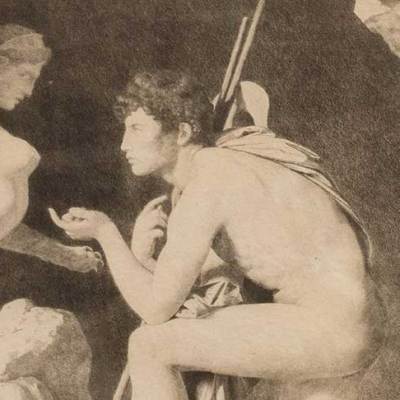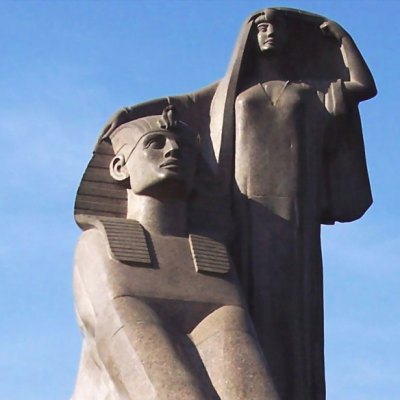Late in December 2019, the Facebook page of the newly created Ministry of Tourism and Antiquities announced that four ram-headed sphinxes, carved around 1200 BC, would be removed from their original emplacements in the Temple of Karnak in the New Kingdom capital of Thebes (modern Luxor). They would be taken 500km north to stand in the traffic circle in Midan Tahrir (‘Liberation Square’), the heart of the modern capital, where they would flank a granite obelisk of the same vintage that had already been brought 130km south from the Temple of Amun in the city of Tanis (modern San el-Hagar). The decision originated from the highest in the land: Egyptian state media reported that President Abdel Fattah el-Sisi envisaged the development of Tahrir as ‘including an extra touch of civilisation, by bringing some archaeological objects and displaying them to the citizens, after restoration, in a way that befits the position and reputation of ancient Egyptian civilization’.
The announcements were met with outrage on social media. The sandstone sphinxes would soon absorb moisture and disintegrate in the relatively humid and heavily polluted air of Cairo, it was (reasonably) claimed. The beautification plan for Tahrir had not been open to competition. Replicas would be just as effective. Why weren’t modern artists commissioned instead? A lawsuit was filed against the move by Egyptian heritage activists and members of parliament, stating that removing monuments from their original setting would violate the industry standard for ethics, the 1964 International Charter for the Conservation and Restoration of Monuments and Sites (the Venice Charter), and could jeopardise the place of Thebes on the UNESCO World Heritage List. UNESCO itself, which avoids all but the gentlest criticisms of its fee-paying member states, has at the time of writing remained quiet; however, the UNESCO-affiliated Arab Regional Centre for World Heritage issued a statement calling for an alternative solution to be found. The response of Khaled el-Enany, Minister of Tourism and Antiquities, as the Ministry for Antiquities had recently become after a cabinet reshuffle, minimised the loss to heritage and maximised the benefit to tourism; the obelisk had been taken from ‘an isolated part of the temple, and the four sphinxes are not part of the landmark ones placed at the front of the temple’. Moreover, ‘When we go to European capitals like Rome or Paris or London, and also Washington, we see that they use Egyptian obelisks in decorating their major tourist squares, so why do we not do the same?’ said el-Enany. ‘We also want to turn Tahrir Square into a major tourist destination in Cairo and in one month all the decoration works for this international place will be completed.’ El-Enany’s complaint that ‘whenever we take moves to make use of our historical heritage we face attacks, and I don’t see any reason for this’ found support among some Egyptian users of social media, who circulated his statement.
The sphinxes were removed from Karnak in the second week of January, as discreetly as could be managed at a popular site at the height of the tourist season. Photos taken by bystanders show them shrouded under tarpaulins, transferred on to concrete stretchers, and loaded on to unmarked trucks. The sphinxes chosen came from the south-west corner of the court behind the first pylon, the temple’s ceremonial entrance, where a host of them are packed tightly together in a line. These are indeed not as prominent as those forming the processional avenue to the temple on the other side of the pylon, but with good reason: they were tucked into their current place in the seventh century BC, when the court was remodelled, and were never redeployed – until now. In Cairo, workmen in Tahrir claimed that the sphinxes and obelisk would be installed for 25 January, the ninth anniversary of the 2011 protests centred on Tahrir that led to the resignation of President Hosni Mubarak. Two and a half years later, more protests in Tahrir helped then-Minister of Defence el-Sisi remove Mubarak’s successor Mohamed Morsi from power, so the symbolism could not be plainer. At the same time, the fate of the obelisk and the rams illustrates the contradictory roles the Egyptian government expects its pharaonic heritage to play: in situ, to embody Egypt’s deep and glorious past; transported out of context to the capital, to advertise the modern state’s efficiency and power.
Tahrir is not the only part of Egypt to receive an obelisk from the little-visited site of Tanis (briefly Egypt’s capital around 1000 BC), where the remains of almost two dozen fallen obelisks have been excavated. The square outside the presidential palace in Alamein City on the Mediterranean coast is also to receive one, and the New Administrative Capital 60km south-west of Cairo has been allotted two, one of which is already used as a backdrop for welcoming visiting heads of state. All the Tanis obelisks were originally erected around 1250 BC by Ramesses II in his new capital city of Piramesse (‘House of Ramesses’ – probably the biblical city of Ramesses), before being removed to Tanis 200 years later to give the new capital a veneer of age. The translation of the obelisks to Egypt’s latest new capital – their third move, if not necessarily their last – has a certain inevitability.
Pharaonic style has had a stranglehold on Egyptian national projects for more than a hundred years, as Egypt gradually achieved independence from the Ottoman and British Empires. Mahmoud Mokhtar, the first Egyptian sculptor to train overseas, created Nahdet Masr (‘Egypt Awakes’, 1928) in the form of a peasant woman raising her veil, while beside her a sphinx eagerly rises up to greet Egypt’s future. Carved out of the same pink Aswan granite as the ancient obelisks, Nahdet Masr was unveiled by King Fuad I outside Cairo railway station, its subject and location implying that Egypt was throwing off the shackles of feudal ignorance to regain her rightful place in the world. A generation later, Gamal Abdel Nasser, who deposed Fuad’s son Farouk in 1952, built the 187m-high Cairo Tower, an elegant mid-century modern concrete lattice with a flaring top inspired by the papyrus-shaped columns of the Temple of Karnak. Cairo legend has it that Nasser paid for the tower with $3m he had received as a bribe approved by the CIA agent Kermit Roosevelt, hence the tower’s nickname of ‘Roosevelt’s erection’. In the present day, the Beaux-Arts-style Egyptian Museum in Tahrir will soon be supplanted by the Grand Egyptian Museum (GEM) rising near the pyramids, which is currently slated to open in October 2020, a little over budget and behind schedule (the original cost of $550m now stands at $1bn and rising, and it was first meant to open in 2015). Pharaonism is built into the Grand Egyptian Museum: the rooflines of its aisles each align with the summits of one of the three Giza pyramids, while the museum’s long facade is made up of interlocking pyramids (originally intended to be translucent alabaster, but now demoted to tinted glass) interspersed with hieroglyphic renderings of the names of eminent rulers. A ‘floating obelisk garden’ – including another obelisk relocated from Tanis – is also planned within the GEM complex. Set against this bewildering array of pharaonic-influenced megaprojects, placing a 15m-high obelisk in a traffic circle seems understated in comparison.
Cleopatra’s Needle-Woman. (A Sight of Sites) published in Punch, 3 November, 1877. Photo: © Look and Learn/George Collection/Bridgeman Images

Monolithic obelisks hewn from hard pink granite were among the greatest engineering feats of the Egyptian New Kingdom (1500–1000 BC). Known to the Egyptians as tekhenu – piercers – they were usually erected in pairs along a temple axis, reaching up to honour the gods and glorify the pharaohs whose names were inscribed down them. Greek visitors to Egypt viewed them with a mixture of admiration and derision, and their belittling description for them – obeliskoi (‘little skewers’) – entered Western use. The similarly snobbish Latin term acus – ‘needle’ – never made the cut outside Italy, but survives in the naming of Cleopatra’s Needles, two obelisks actually taken by Augustus from Heliopolis (near Cairo airport) and re-erected in Alexandria in 12 BC. Roman emperors extracted many obelisks from Egypt to adorn their circuses, gardens, and imperial mausoleums, and christened the new capital of Constantinople in 390 AD with the last obelisk to leave Egypt for nearly 1,500 years. It is both an irony of history and a useful pub quiz factoid that the city of Rome has more standing obelisks than the whole of Egypt combined, by a margin of 13 to (currently) seven. Seicento and settecento popes re-erected fallen obelisks as part of Rome’s Counter-Reformation makeover: Sixtus V and his engineer Domenico Fontana erected four between 1586–89, a record Egypt has yet to break (although the Grand Egyptian Museum has just created the world’s largest coffee-cup mosaic, using 7,260 cups to depict – what else? – the Mask of Tutankhamun).
In the 19th century, Egypt’s Ottoman viceroys found antiquities a handy currency. Britain and France were given obelisks in 1819 and 1833 respectively, as Mohamed Ali Pasha sought to modernise his country and stay on the right side of the Great Powers. A French expedition was dispatched to bring its obelisk back from the Temple of Luxor (where its twin still stands), and Louis-Philippe had it erected in Paris in 1836. The erection of the obelisk – placed almost exactly where Louis XVI was executed in 1793 – was the highlight of the July Monarchy’s refurbishment of the Place de la Concorde (‘Harmony Square’) as a shrine to national unity. London was less keen to take up its obelisk, one of Cleopatra’s Needles, and held fire on retrieving it for more than 50 years. It took celebrity dermatologist Erasmus Wilson’s offer to pay for its transport to kick-start its removal in 1877. The Board of Works did not overexert itself to find a fitting place for the Needle, declining sites in front of Parliament (too dangerous) and the British Museum (too far away from the Needle’s mooring by the Thames) to leave it in its present discreet spot on the Victoria Embankment. Three years later, 9,000 Freemasons paraded through New York to celebrate the erection in Central Park of Cleopatra’s other Alexandrian Needle, the last obelisk to leave Egypt.
The events held to celebrate the installation of the obelisk and sphinxes in Tahrir will not involve Freemasons – Nasser closed the lodges – but are otherwise sure to be just as triumphal. Like Louis-Philippe’s erection of the Place de la Concorde obelisk, it will be presented as another successful national enterprise, marking a new chapter for Tahrir. Concerns over pollution and world heritage never bothered 19th-century obelisk hunters, so what should stop Egypt re-arranging her own assets in her own interests? Querulous archaeologists and Egyptologists are about to be reminded that history may be written by historians, but it is made – and moved – by armies.
From the February 2020 issue of Apollo. Preview and subscribe here.


